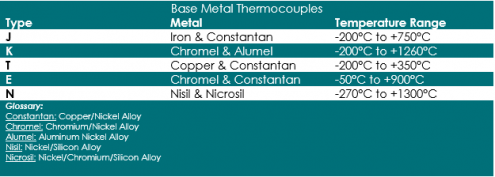What is a Thermocouple?
게시됨 1월 07, 2019 으로 Advanced Energy Editor
What is a Thermocouple?
So, what exactly is a thermocouple? It is two wires of dissimilar metals that produce a thermoelectric voltage when the two ends are at different temperatures. There are three “families” of materials from which thermocouples are made. (See Charts Below)
Some History on Thermocouples
In the 1820’s Thomas Seebeck experimented with a circuit of Bismuth-Copper and Bismuth-Antimony and showed that when the two junctions of the two materials were at different temperatures they produced a sustained current – converting thermal energy to electric energy.
This effect is known as the Seebeck Effect and it is the basis for the thermocouples we use today. A thermocouple develops a thermoelectric voltage based upon the difference in temperature between the hot end and the cold end. So, in effect, a thermocouple measures a differential temperature.
To convert this differential voltage to a known temperature, you need to know the temperature at one end. Historically this was done by insulating one end and placing it in an ice bath at 0°C. This became known as Cold Junction Compensation. Through time and experience, the best materials were selected and standardized to generate a stable thermoelectric voltage, and conversion tables were developed with the cold end at the ice point 0°C. These were finally recognized in 1990 and the ITS-90 international temperature scale was released internationally with the latest thermoelectric tables for recognized thermocouple types.1
Thermocouple Types, Composition and Temperature Ranges
The selection of thermocouple types depends upon many factors including corrosion resistance, temperature range, thermoelectric voltage, cost, availability, compatibility with instrumentation etc.
.png?lang=en-US)



What Are the Uses of Thermocouples Thermometers?
Thermocouples are the most versatile temperature sensors available. They are THE most popular temperature sensors in North America and are number two in Europe, next to RTD thermometers and probes. They are used to measure temperature in gasses, liquids, and contact measurements of solids as well as for the interior or core measurements of penetrable materials such as food products. Their range is roughly -200 to 2000 °F and their accuracy is 1-4°F depending on the type and application.
Many of our TEGAM thermocouple thermometers are washable and several models are Intrinsically Safe for potentially hazardous applications within industries such as aerospace, automotives, pharmaceuticals, oil & gas, chemicals, textiles, mining, and even some food processing operations.
TEGAM designs and manufactures thermometry products including Digital Thermometers, Thermocouple Probes and Thermocouple Thermometers for industrial and scientific applications worldwide. View TEGAM’s Temperature Probe Selection Guide here.
If you need assistance or have any questions on thermocouples or their applications, please contact us here to get started.
